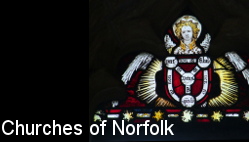
home I index I latest I glossary I introductions I e-mail I about this site
St James, Crownthorpe
Follow these journeys as they happen on X/twitter.
St James, Crownthorpe You don't have to travel far outside the town of Wymondham to find yourself lost in narrow lanes threading through undulating fields, a part of Norfolk where the population reached its peak in the 1850s, and it has been downhill ever since. The villages and hamlets out here are rambling and tiny, and one of them is Crownthorpe. At the time of the 1851 census the parish had just a hundred people living in it, making it one of the smallest parishes in Norfolk. Between a third and half of them made their way to their parish church on a typical Sunday, a high proportion for Norfolk. A mark of the way that the ecclesial landscape was changing at this time is given by the Rector of Crownthorpe, Francis Raikes, who remarked that the Sunday Scholars are not put down in the average because they have been in attendance only this year and but few of them are resident in the parish. Raikes was a young man, just 28 years old at the time of the census, and he had recently married. He was probably part of that wave of young parsons coming out of Oxford and Cambridge brimming with the ideas of the Tractarians, a movement that would completely change the face of the Church of England over the next few decades. He was also rector of neighbouring Carleton Forehoe, providing him with a joint income of £330 a year, roughly £60,000 in today's money, not bad for a newly-married young priest. But the energy and
confidence of the Church of England drained in the second
half of the 20th Century, and a number of churches fell
into disuse, including this one. It was declared
redundant in the 1970s, and when Birkin Haward visited in
the 1980s he found it ruinous. After lying derelict for
some years, the building was sold, rescued, and it is now
a private house. You can see clearly that this was a
considerable medieval church, mostly from the early 14th
century in the years before the Black Death. Pevsner
thought that the odd, stark top to the tower was probably
an 18th Century repair, and that 19th Century
restorations had given the building its east window
tracery and roof. He also noted that there had once been
two transepts, and that the arch to the southern one was
still discernible. In the archives at Felbrigg, Ketton-Cremer found a rather startling letter that Nevar wrote to Windham from Crownthorpe on his wedding day. It begins Sir, I date this letter from the happiest day of my life, a Levitical conjurer transformed me this morning from an Insipid, Unrelishing Batchelour into a Loving Passionate Husband... Colonel Finch tells me of dismal dangers I am to run before the next sun shines upon me, but the Spouse of my bosom being of a meek, forgiving temper, I hope she will be mercifull, and not suffer a young beginner to die in the experiment. I commend myself to your best prayers in this dreadfull juncture... The manor of Crownthorpe was eventually sold off with the rest of the Windham possessions in the 1860s, after 'Mad' Frederick Windham bankrupted himself and his estates in the process of having to prove his sanity in a court of law. Today, St James remains a part of the landscape as it has done for centuries, the only signs that it is no longer a church are the private gardens which surround it and the television aerial on the top of its tower. Simon Knott, January 2024 Follow these journeys as they happen on X/twitter.
|
|
||||||||||||||||||||||||||||||||||||||||||||||||||||||
home I index I latest I introductions I e-mail I about
this site I glossary
Norwich I ruined churches I desktop backgrounds I round tower churches
links I small
print I www.simonknott.co.uk I www.suffolkchurches.co.uk